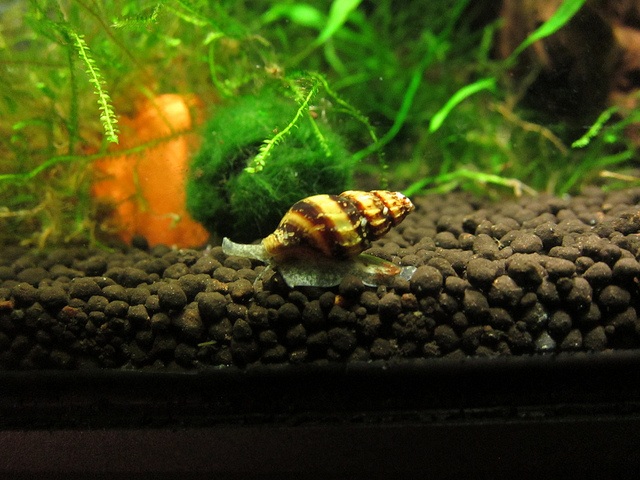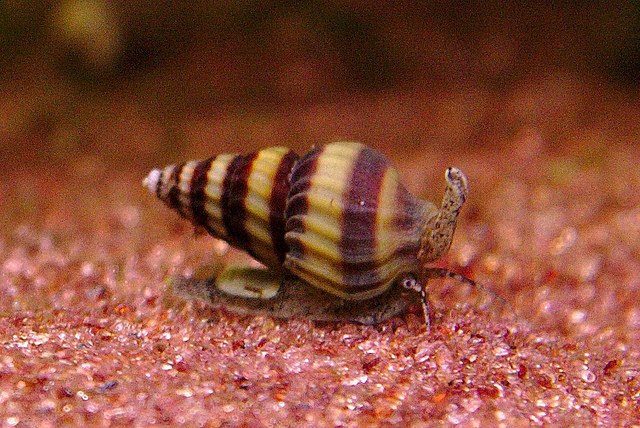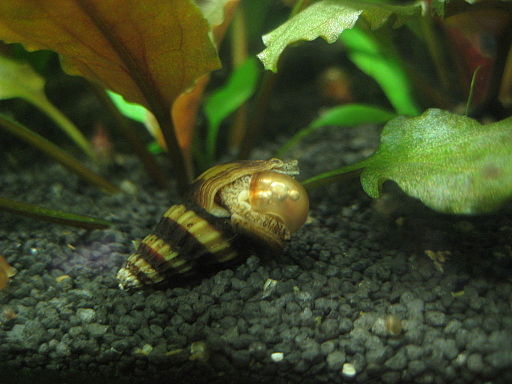When you think of adding snails into your home aquarium, you’re not likely to assume that they will demand more attention than your fish. If you want to introduce an assassin snail to your tank, however, you must do so with great forethought.
Assassin snails defy snail expectations; they are an unusually aggressive species.

While their attitudes and voracious diets make them exceptionally useful when trying to conquer an invasion of pest snails in your tank, you may find yourself surprised by the potential interactions these snails may have with other tankmates.
Peruse this guide on the care and keeping of the assassin snail to determine whether or not you want to bring them into your current tank, if you want to establish them in a tank of their own, or if their aggressive nature might make them a better pet for someone else.
Contents
Assassin Snail Personality and Appearance
Appearance and Size
Assassin snails are also known as bumblebee snails. The yellow and dark brown stripes on their shells make them stand out in an aquarium and in the wild, though they make beautiful additions to the schools of fish they may live among while in captivity.
These carnivorous critters aren’t always the easiest to live around, though, when you’re a fish. Assassin snails live up to their name, as will be explored later on, but suffice to say that picking out tankmates for these snails can be a bit of a challenge.
Speaking of challenges: the assassin snail differs from other species of snail, in that assassin snails can be assigned a sex. Male assassin snails have distinctly different sex organs than females. All the same, it can be difficult, if not impossible, to casually tell a male apart from a female.
The difference in snail sex only comes into play when you’re looking to get into assassin snail breeding.

Personality
These creatures prefer to live in freshwater environments and are especially sensitive to the quality of water in which they live, making them a little more high maintenance than other species.
They don’t, additionally, breathe air, like a zebra snail would, which means that the tanks they live in can be a little more contained, and they’re not likely to wander out of the water.
They remain a challenging snail to keep, though. It’s not impossible to provide these creatures with a positive and enriching habitat, but you will have to go about the process of setting up your tank properly and with careful consideration.
If you do your research, you’ll find that you can have your assassin snails living in a single-species community or in the company of other fish without a problem – and in little to no time at all.
Assassin Snail Care
Statistics
With the basics in mind, you can move onto the details of assassin snail care. Each member of your to-be aquarium will have a particular set of habitat requirements that need to be met.
The challenge (not just for assassin snail owners, but for hobbyists looking to set up aquariums, in general) is establishing an ecosystem wherein multiple species can live healthily and harmoniously.
Consider some of the assassin snail’s ecological needs and biological traits, as listed here.
- Preferred tank pH levels: 7.5 to 8.0.
- Temperature Range: 65 to 80 degrees Fahrenheit.
- Water Hardness: Hard to Exceptionally Hard.
- Average Size: Half an inch.
- Aquarium Size: 10 gallons, minimum.
- Feeding: Carnivore.
Natural Habitat
These species are referred to as “assassin snails” for a reason. They are a predatory snail that likes to hide in the sandy substrates of streams and ponds before attacking their prey.
Combine this urge to hunt with their love of warmer waters, and you’ll understand why the assassin snail is most commonly found in Thailand, Malaysia, Indonesia, and other bodies of freshwater in Southeast Asia.
The assassin snail does about as well in captivity as it does in the wild; the average assassin snail lifespan, in an aquarium or otherwise, is roughly two years.

It’s in your best interest, all the same, to try and emulate the assassin snail’s natural habitat when you bring the critters into your home.
Water Requirements
The assassin snail’s basic water requirements have already been touched on; they prefer warmer waters with a higher than average acidity and hardness.
Their sensitivity to the water in which they live, though, should be noted. Assassin snails will respond poorly to water that’s been improperly treated or that doesn’t suit their needs.
When establishing a tank for your assassin snails to live in, you’ll want to keep the aforementioned water requirements in mind in order to preserve the health of your snails.
If the water is improperly treated, your assassin snails could fall victim to parasites or other water-borne illnesses.
Tank Requirements
Before you start playing with water, though, you need an appropriately sized tank. At a minimum, a tank for your assassin snails alone should hold ten gallons of water.
If you’re looking to introduce your assassin snails to a pre-existing tank, you may want to look into expanding your habitat to better address the needs of the snails along with the fish you’re introducing them to.
When it comes to housing snails with other species of fish, it’s often easiest to determine ideal tank size by deciding what minimum size tank suits the fish, first, then adding ten gallons in size to account for the snails.
Whatever you do, though, do not introduce your assassin snails into a tank where you’ve been breeding other species of fish. As will be elaborated on later, assassin snails are fiercely carnivorous creatures. Any fry is at serious risk, should they be exposed to assassin snails in a tank.
In order to keep your assassin snails occupied, you’ll want to establish a sandy substrate in the bottom of your tank.
Even when not exposed to a plethora of live companions, assassin snails will need to address their instinctual urge to stalk prey (most likely in the form of bloodworms or live food) from the depths of a substrate.
Without this addition, your assassin snails may become agitated and overly aggressive, destabilizing the balance of whatever ecosystem you have them living in.
Assassin Snail Companions and Temperament
As has been hinted at a number of times, assassin snails are a particularly aggressive species of snail.
They are not necessarily group animals, and they tend to eat any smaller tank companions who happen to cross their path.

Group creatures or not, assassin snails will still hunt in packs in order to take down larger fish that they consider prey. That is not to say that all other fish will be helpless if left in a tank with a group of assassin snails.
These snails can be preyed upon by cichlids and will die when placed under too much stress, either from an overly busy ecosystem or an excess of predators.
If you’re really looking to pair your assassin snails with friendlier tankmates, tropical fish tend to make inoffensive companions.
Apple snails, too, can live alongside a group of assassin snails without fear of harm. That isn’t to say that a brave – or hungry – assassin snail won’t take a nip at its companions, but these types of tankmates are more likely to be able to hold their own without upsetting the balance of predator and prey within a tank.
Feeding
Why, if they cause so much trouble, would you introduce assassin snails into one of your tanks? Because, beyond their aesthetic look, this species will consume invasive pest snails.
Feeding assassin snails is no difficulty; rather, you will find yourself trying to find things (stimuli, companions, and so on) that are not a part of their snail diet.
Assassin snails are opportunistic eaters. They will eat fish eggs, fry, planaria, frozen or fresh fish food, bloodworms, and live prey if they have the chance, and while their ability to hunt pest snails is exceptionally useful, they have also been known to utterly decimate snail populations.
If you find yourself unable to feed your assassin snails any of their traditionally preferred foods, shrimp wafers or sinking wafers will serve them well.
As hunters and scavengers, assassin snails have adapted to survive on whatever they can find. You may, as such, find yourself asking, “Will assassin snails eat each other?”
If underfed or bored, it is entirely possible that your assassin snail population will turn on itself. However, it is not the assassin snail’s first instinct to eat its kin. Maintain a healthy diet for your collection of snails, and you shouldn’t experience any issues of the sort.
Breeding
In a similar vein, you don’t have to worry about assassin snails consuming their own young. If you’re looking to breed them, you’re in luck – it is not especially difficult for these snails to reproduce.

As previously mentioned, they have defined sexes; only the female assassin snails can reproduce. These snails most often breed when in large groups.
Males and females will lock together for twelve hours, and within three to eight weeks, square-shaped eggs will appear in your tank.
Upon hatching, assassin snail fry will bury themselves in the provided sandy substrate in order to stay safe, emerging only once mature and ready to join their kin.
You’ll want to take care, when breeding assassin snails, that you don’t let the population grow too large. Not only will their aggressive nature potentially get the best of them, but you’re likely to put a strain on the sharing of food within a tank, should the population get too numerous.
Assassin snails thrive most effectively when in groups of eight to ten, or when there is plentiful space to put between them and their kin.
Here’s a video showing more information on assassin snails.
Do you have any tips on owning assassin snails?

